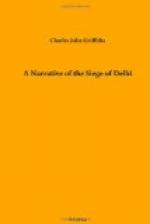A favourite hiding-place for valuables was behind the staircase, the treasure being concealed in a sort of vault built around with bricks and cement. On one occasion, in the house of a money-changer, we demolished a secret place of this kind and discovered four large bags filled with some heavy metal. Feeling convinced we should find that the bags contained at the least rupees, we opened one, and to our infinite disgust saw that the contents consisted of copper pieces called pice, of which there were many thousands; the bags, however, were taken to the prize agents, but I need scarcely say our hands on that day at least were not soiled by appropriating a portion of the plunder.
On several occasions we succeeded in finding large stores of money, chiefly sicca or native rupees, while in the houses of Hindoos, in portions of the walls which sounded hollow under the blow of the hammer, we, after making a hole sufficiently large for the passage of a hand, constantly brought to light large stores of silver ornaments, consisting of chains, bracelets, etc., amounting in the aggregate to a barrowful. Few houses there were that did not furnish, after a diligent search either in the floors or walls, some articles of value; but on only one occasion after the successful ventures in the two first cases was the amount of loot in any way comparable to that which we obtained on those days.
In a very secluded part of the city, in a large house, surrounded by wretched tenements inhabited by the lowest class, we opened a door, and to our amazement entered a room furnished in the European fashion. This also had not escaped the marauding and destructive hands of parties of plunderers; the furniture was smashed, and the contents of the room strewn about the floor. There were English chairs, curtains, ottomans covered with antimacassars, sofas and broken mirrors, and in the corner a small piano, ruined and destroyed. The house had evidently belonged to some rich native, but who had been the occupant of this boudoir? for such it was—a miniature drawing-room filled with European luxuries, not excepting books and copies of music. Articles of a lady’s apparel also lay about, torn in shreds, vases were on the mantelpiece, as well as a small box filled with English fancy needlework. We came to the conclusion that the mistress of this abode must have been a Eurasian lady, probably one of the zenana of the master of the house, who during the exodus from the city had fled with, or been forcibly carried away by, her protector.




